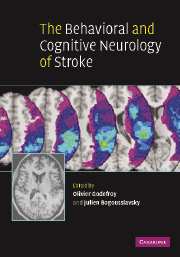Book contents
- Frontmatter
- Contents
- Contributors
- Preface
- 1 Evaluation of cognitive and behavioral disorders in the stroke unit
- Motor and gestural disorders
- Aphasia and arthric disorders
- Hemineglect, Anton–Babinski and right hemisphere syndromes
- Agnosia and Bálint's syndrome
- Executive and memory disorders
- Behavioral and mood disorders
- 22 Akinetic mutism and related disorders
- 23 Alterations of level of consciousness related to stroke
- 24 Delirium and confusional state in stroke patients
- 25 Post-stroke delusion
- 26 Acute behavioral and mood changes
- 27 Stroke and personality change
- 28 Post-stroke mania
- 29 Depression after stroke
- 30 Fatigue
- Dementia and anatomical left/right syndromes
- Index
- References
26 - Acute behavioral and mood changes
Published online by Cambridge University Press: 10 October 2009
- Frontmatter
- Contents
- Contributors
- Preface
- 1 Evaluation of cognitive and behavioral disorders in the stroke unit
- Motor and gestural disorders
- Aphasia and arthric disorders
- Hemineglect, Anton–Babinski and right hemisphere syndromes
- Agnosia and Bálint's syndrome
- Executive and memory disorders
- Behavioral and mood disorders
- 22 Akinetic mutism and related disorders
- 23 Alterations of level of consciousness related to stroke
- 24 Delirium and confusional state in stroke patients
- 25 Post-stroke delusion
- 26 Acute behavioral and mood changes
- 27 Stroke and personality change
- 28 Post-stroke mania
- 29 Depression after stroke
- 30 Fatigue
- Dementia and anatomical left/right syndromes
- Index
- References
Summary
Introduction
Motor, sensory, and cognitive deficits are classically recognized as clinical signs of stroke. It was only during the twentieth century that modifications of affective and emotional behavior were recognized in cerebrovascular diseases, with Kraepelin (1921) first describing an association between depression and atherosclerotic diseases. Later, Goldstein (1948) described the catastrophic reaction observed in brain-injured patients, but it was only in the 1970s that Gainotti (1972) conducted the first systematic study of emotional symptoms associated with brain lesions. When talking about mood changes it is not always clear in the literature whether it refers to affective disorders included in psychiatric disturbances or to emotional disorders. Since other chapters in this book are dedicated to mania, depression, and delusion, we will focus on emotional and behavioral modifications related to stroke.
Emotional modifications
The study of emotion in stroke patients is particularly difficult because the variables involved are multiple and complex. One problem is the definition of emotion itself, since it can be expressed in three main ways (Eysenck, 1975, p. 439): a subjective feeling or state experienced by the patient (e.g. sadness, anger, happiness, fear, disgust, surprise), physiological reactions characterized by somatic visceral–autonomic responses (e.g. increased heart rate, blood pressure, salivation, perspiration) and a behavioral component that can be observed (e.g. running away when afraid or smiling when happy). As far as stroke patients are concerned, the study of subjective feelings is extremely difficult since it excludes aphasic patients.
- Type
- Chapter
- Information
- The Behavioral and Cognitive Neurology of Stroke , pp. 520 - 528Publisher: Cambridge University PressPrint publication year: 2007



